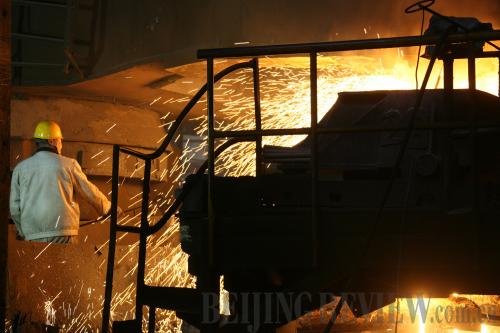|
 |
|
TEMPERING THE SOES: A worker at the state-owned Shougang Group among the sparks and flames of the steel-making process. While the state-owned sector remained stable in 2009, SOEs face new challenges this year (XINHUA) |
More than 30,000 state-owned enterprises (SOEs) operate in China, of which 129 are supervised by the Central Government. The others fall under the jurisdiction of local governments. Based on 2009 performance announcements issued by the enterprises and figures released by the State-Owned Assets Supervision and Administration Commission of the State Council (SASAC), about 15 percent of central SOEs and 28 percent of local SOEs are expected to lose money within the year.
"We should be resolved to close those enterprises that are losing money in the long term," said Li Rongrong, Minister of the SASAC, at a national conference on state-owned assets supervision and administration held in Beijing on December 24, 2009.
The announcement of Li, though made for the first time by a supreme administrator of China's state-owned assets, did not elaborate on the definition of "long term."
SOE losses are a sensitive issue for most of the Chinese people. Once losses are recorded, SOEs receive financial support from the SASAC to make up for the deficits. The SASAC money, however, comes from taxpayers' wallets. After China's three largest state-owned airlines incurred staggering losses in 2008, the SASAC provided them with subsidies totaling more than 10 billion yuan ($1.46 billion).
Closing SOEs that are losing money in the long run would be a major benefit for the country, relieving the burden on the state and staying in line with the desires of the public.
Generally healthy development
While 2009 proved to be a truly challenging year for China's economic development, the state-owned sector has remained generally stable, with major indicators of business operation starting to pick up steadily, according to Li.
SASAC figures showed that from January to November 2009, local SOEs generated business revenues of 5.9 trillion yuan ($863.84 billion), increasing 2.8 percent year on year and putting an end to negative growth in the first 10 months of the year. Their profits earned totaled 258.39 billion yuan ($37.83 billion), a decline of 6.5 percent from the previous year, which was 11.7 percentage points lower than the decrease in the first 10 months of 2009.
In the first 11 months of 2009, central SOEs generated business revenues of 11.1 trillion yuan ($1.63 trillion), a year-on-year increase of 3.4 percent, with profits totaling 710.96 billion yuan ($104.09 billion), also up 3.4 percent from the year before. The central SOEs' tax payment hit 996.38 billion yuan ($145.88 billion), up 7 percent compared with the same period in 2008. Current estimates hold that in 2009, central SOEs may have generated business revenues of 12 trillion yuan ($1.76 trillion) with profits of 750 billion yuan ($109.81 billion).
Currently, exact numbers of SOEs that are losing money over the course of two, three or even five years are still unavailable.
As indicated by the SASAC figures, certain loss-incurring SOEs at different levels in 2009 may have weighed down the overall growth, but the number of SOEs to be closed for long-term losses would be relatively small. As a result, the closure of SOEs that have been losing money for a long time will not affect the overall volume of the state-owned economy.
The development outlook for SOEs in 2010, however, won't be easy, Li said. "The environment for China's economic development in 2010 will be better than in 2009, but SOEs are still facing a very complicated situation," he said.
The first challenge will be the influence of the general economic environment, Li said. The base for the world economic recovery in 2010 has yet to solidify, the consumption market remains sluggish, economic development lacks new growth points and the damaged international financial system still restricts the real economy. Domestically, the driving force for economic growth remains weak and structural problems, such as redundant construction and excess capacity, are still abundant. Enterprises are facing growing pressures from energy conservation, emission reduction and the development of a low-carbon economy.
Weak points in the SOEs themselves—imperfections in their corporate governance structures, irrational industrial layouts in some regions and weak independent innovation capabilities—have also restricted development.
"In 2010 the core of state-owned assets supervision and SOE development is to improve the quality and returns of the state-owned economy, with the focus of work laid on transforming the development pattern of SOEs," Li said.
Intensifying risk controls
Most of the current losses incurred by SOEs are rooted in their operational mechanisms instead of business factors, such as raw material price hikes and growing production costs.
| 